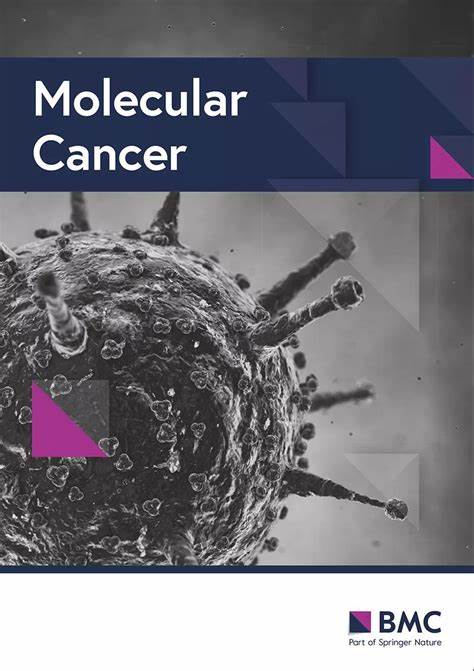Targeting the HER2-ELF3-KRAS axis: a novel therapeutic strategy for KRASG13D colorectal cancer.
IF 33.9
1区 医学
Q1 BIOCHEMISTRY & MOLECULAR BIOLOGY
引用次数: 0
Abstract
Colorectal cancer (CRC) is one of the most prevalent cancers worldwide, with KRAS mutations playing a significant role in its tumorigenesis. Among the KRAS variants, the G13D mutation is associated with poor prognosis and distinctive biological behaviors. This study focuses on the role of HER2, a critical prognostic and predictive biomarker, in modulating the unique characteristics of KRASG13D-mutated CRCs. We identified a novel transcriptional regulatory network involving HER2, ELF3, and KRAS, with ELF3 acting as a key transcription factor (TF) that regulates KRAS expression under conditions of HER2 overexpression. Our findings reveal that this HER2-ELF3-KRAS axis is exclusively activated in KRASG13D, driving aggressive oncogenic features and conferring resistance to cetuximab (CTX) therapy. Through comprehensive analysis of gene expression profiles, we demonstrated that HER2 is a crucial therapeutic target specifically for KRASG13D CRCs. To explore this further, we introduced YK1, a small molecule inhibitor designed to disrupt the ELF3-MED23 interaction, leading to the transcriptional downregulation of HER2 and KRAS. This intervention significantly attenuated the HER2-ELF3-KRAS axis, sensitizing KRASG13D CRCs to CTX and reducing their tumorigenic potential by inhibiting the epithelial-to-mesenchymal transition process. Our study underscores the importance of HER2 as a key determinant in the unique biological characteristics of KRASG13D CRCs and highlights the therapeutic potential of targeting the HER2-ELF3-KRAS axis. By presenting YK1 as a novel pharmacological approach, we provide a promising strategy for developing tailored interventions for KRASG13D CRCs, contributing to the ongoing efforts in precision medicine for CRCs.靶向HER2-ELF3-KRAS轴:KRASG13D结直肠癌的新治疗策略
结直肠癌(CRC)是世界范围内最常见的癌症之一,KRAS突变在其肿瘤发生中起着重要作用。在KRAS变体中,G13D突变与不良预后和独特的生物学行为相关。这项研究的重点是HER2在调节krasg13d突变的crc的独特特征中的作用,HER2是一种关键的预后和预测性生物标志物。我们发现了一个涉及HER2、ELF3和KRAS的新型转录调控网络,其中ELF3作为HER2过表达条件下调节KRAS表达的关键转录因子(TF)。我们的研究结果表明,HER2-ELF3-KRAS轴在KRASG13D中被完全激活,驱动侵袭性致癌特征并赋予对西图昔单抗(CTX)治疗的抗性。通过对基因表达谱的综合分析,我们证明HER2是KRASG13D crc特异性的关键治疗靶点。为了进一步探讨这一点,我们引入了YK1,一种小分子抑制剂,旨在破坏ELF3-MED23的相互作用,导致HER2和KRAS的转录下调。这种干预显著减弱了HER2-ELF3-KRAS轴,使KRASG13D crc对CTX敏感,并通过抑制上皮细胞到间质细胞的转化过程降低了它们的致瘤潜能。我们的研究强调了HER2作为KRASG13D crc独特生物学特性的关键决定因素的重要性,并强调了靶向HER2- elf3 - kras轴的治疗潜力。通过将YK1作为一种新的药理学方法,我们为开发针对KRASG13D crc的量身定制干预措施提供了一种有希望的策略,为crc的精准医学做出了贡献。
本文章由计算机程序翻译,如有差异,请以英文原文为准。
求助全文
约1分钟内获得全文
求助全文
来源期刊

Molecular Cancer
医学-生化与分子生物学
CiteScore
54.90
自引率
2.70%
发文量
224
审稿时长
2 months
期刊介绍:
Molecular Cancer is a platform that encourages the exchange of ideas and discoveries in the field of cancer research, particularly focusing on the molecular aspects. Our goal is to facilitate discussions and provide insights into various areas of cancer and related biomedical science. We welcome articles from basic, translational, and clinical research that contribute to the advancement of understanding, prevention, diagnosis, and treatment of cancer.
The scope of topics covered in Molecular Cancer is diverse and inclusive. These include, but are not limited to, cell and tumor biology, angiogenesis, utilizing animal models, understanding metastasis, exploring cancer antigens and the immune response, investigating cellular signaling and molecular biology, examining epidemiology, genetic and molecular profiling of cancer, identifying molecular targets, studying cancer stem cells, exploring DNA damage and repair mechanisms, analyzing cell cycle regulation, investigating apoptosis, exploring molecular virology, and evaluating vaccine and antibody-based cancer therapies.
Molecular Cancer serves as an important platform for sharing exciting discoveries in cancer-related research. It offers an unparalleled opportunity to communicate information to both specialists and the general public. The online presence of Molecular Cancer enables immediate publication of accepted articles and facilitates the presentation of large datasets and supplementary information. This ensures that new research is efficiently and rapidly disseminated to the scientific community.
 求助内容:
求助内容: 应助结果提醒方式:
应助结果提醒方式:


